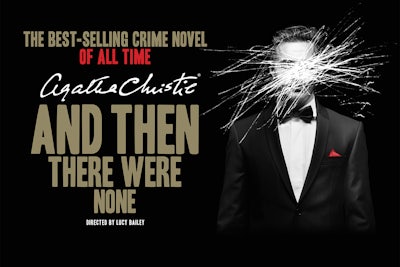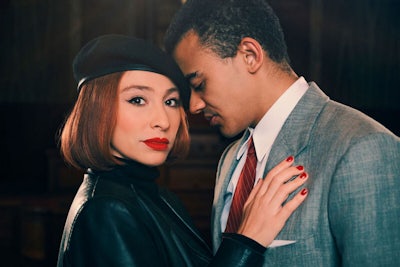Features
Investigating Agatha Christie's Stage Success

Written by playwright and screenwriter Chris Thompson
Agatha Christie is the only woman to have three plays to run concurrently in the London’s West End, she is beloved by audiences around the world, and yet when we try to name her plays, often we can only get as far as The Mousetrap.
Throughout my career as a playwright, I’ve taught and mentored writers at all levels. One thing I encourage writers to do every day - other than write - is read. I have a long list of plays from across the canon that I think will help illuminate the craft of dramatic writing to emerging and established writers alike. But to my shame, it’s only in the last three years that I’ve added Agatha Christie to that list.
Delving back into her catalogue, as I did during Covid, I was astonished to discover how much she experimented with form; how her plays are character-led and rich with complex psychology and moral ambiguity; and how, above all, she masters structure.
I’m going to discuss some of her better-known plays, because you’re more likely to be able to see them performed, but I also want to shine a light on a couple of her lesser-known works for stage and radio. In doing so, I want to show that we can all learn something from the UK’s most successful female playwright.

Theatre performance is essentially the transfer of information from one side of the room to the other. A group of actors congregate onstage and give the information they have to the audience. But what creates drama and meaning is the order in which this information is given. No matter the genre or subject, all writers will face the question of how and when they give their information to the audience. This is particularly pertinent to the ‘mystery’ genre, for which Christie is most well-known.
I encourage all writers to do an “information audit’ on their work. This involves moving chronologically through the play and auditing what the characters know and when, and cross referencing this with what the audience knows and when. By doing so, you get a clear sense of what the audience is experiencing moment by moment, allowing you to adjust the pace and address any structural gaps.
Apply this exercise to any Agatha Christie play, you’ll see how controlled and masterful she is at revealing information about character and plot.
For example, in And Then There Were None (an adaptation of her novel), the characters come to the realisation that they are being murdered one by one. It’s arguably her most complex and meticulously constructed play. Tension is derived not only from the unfurling mystery, but also the joy of the audience figuring out that the character’s worst fears are indeed true. Even though the audience has no additional information than the characters, Christie allows the audience to get one step ahead of the characters, as we are invited to speculate: who is next? This structure ratchets up the tension while at the same time providing Christie with a precinct to discuss universal themes of guilt, responsibility, and retribution.
Arguably, the majority of the tension and drama inherent in Christie’s plays come from her choice of structure and form. For example, some Christie plays observe the classical unities of action, place and time. These principles of dramatic structure originated in ancient Greece and were later formalised during the Renaissance, particularly among French writers such as Racine and Corneille. These principles suggest that a dramatic work should have a single plot, observe unity of time (such that the events occur in a relatively short and continuous time frame), and that the events occur in the same place.
The classical unities serve to intensify the drama, heighten suspense and allow focus on character and theme. So perhaps it’s no surprise that Agatha Christie chooses to employ them in certain of her plays. But this structure poses its challenges. Not least, the need to somehow dramatise past events in the present tense. It’s here Christie excels.

Christie’s play, Spider's Web, adheres to classical unities most firmly. The play takes place in one setting, occurs in real time and follows one single story line. But whereas historically, writers like Racine and Corneille employed the classical unities for tragedy, Spiders Web is one of Christie’s funnier works. It deftly navigates the intersection between farce and tragedy. Re-reading it, I was reminded of Joe Orton’s work - farce, absurdity, social commentary all trojan-horsed into a finely crafted ‘well made’ play.
The Mousetrap is another work in which Christie uses the classical unities, although here the timeframe is around 24 hours. What I love most about The Mousetrap is Agatha Christie’s deft control of tone. The opening scene feels light and is often funny, but as the evening progresses, Christie takes us from a major key to a minor key, bringing us to a thrilling denouement (or two) examining complex themes such as childhood trauma and betrayal.
Spiders Web is one of Christie’s funnier works. It deftly navigates the intersection between farce and tragedy.
I’m also fascinated by the way Christie asks us (the audience) to participate in her plays. She has a keen understanding of the live event. In Witness for the Prosecution we are asked to make the same decisions as the characters on stage - who do we trust? Who do we believe? And then we share in the collective enjoyment of realising we’ve been blindsided.
Or take the character of Paravicini in The Mousetrap. His wry, self-referential asides and outsider status position him as our surrogate in that world: he’s our way into the story. It’s moments like these that give Christie her enduring appeal. Our pleasure comes not solely from the story itself, but equally the way in which the story is told to us. By this I mean that Christie’s presence as the writer is felt strongly throughout her plays. She reminds us she is there. So the audience enjoys a relationship with the characters on stage, but also a relationship with Christie herself. We leave the theatre thrilled and charmed, but also doffing our hat to the omnipotent writer who fooled us again.

If you’re doing a deep dive of Christie’s plays, don’t overlook her shorter works for the stage or her radio plays. In particular the radio play Butter in a Lordly Dish, which, rather than starting with a dead body, dramatises the anatomy of a murder over a tense hour. It starts deliciously with a gossipy mum and daughter bemoaning a recent murder case for being too dull - another wry wink from Christie. Structurally, we’re not solving a murder, we’re hearing one slowly fall into place. Rather than a whodunnit? This is a who’s-doing-it? (Akin to And Then There Were None.) And when we finally figure out what’s going on, we’re helpless to stop it.
Similarly in her one act play The Rats Christie stuffs the play with a remarkable number of twists and turns in the space of 30 minutes. Particularly striking is how she creates intrigue from the very first page, over the mix up of invitations to a party. Within seconds we are leaning in, wanting to know more.
And it’s this desire to entertain, that I think all writers can learn from. In her stage work, Christie was playful and surprising in how she used form, and she coupled this with her prodigious technique in dramatic construction. I encourage all writers to investigate Christie’s technical mastery as a way to unlock and inspire their own.
About Chris Thompson
Chris Thompson is an award winning playwright and screenwriter. His plays include Of Kith and Kin, Albion, Carthage, Dungeness. His work has been performed at some of the most prestigious theatres in the UK including the National Theatre, The Royal Court, and the Bush Theatre. Internationally, his work has been seen in the USA, South Korea and Peru.
Visit Chris Thompson's website


 USA
USA 